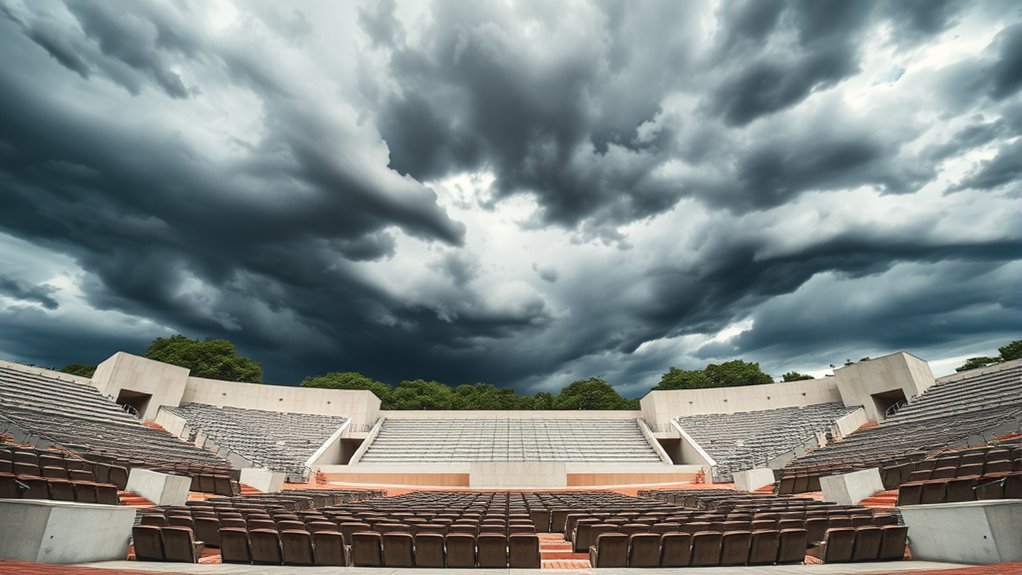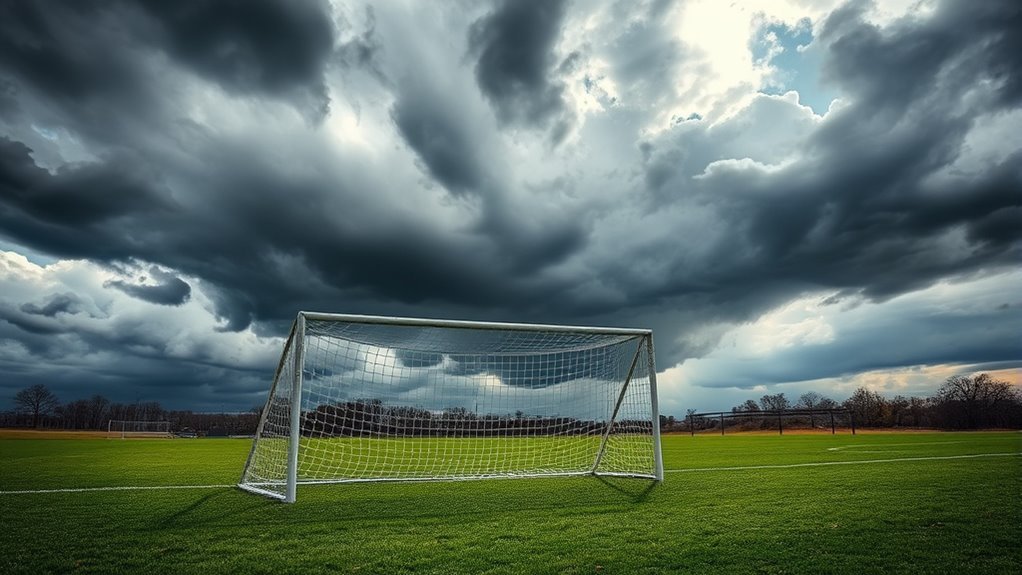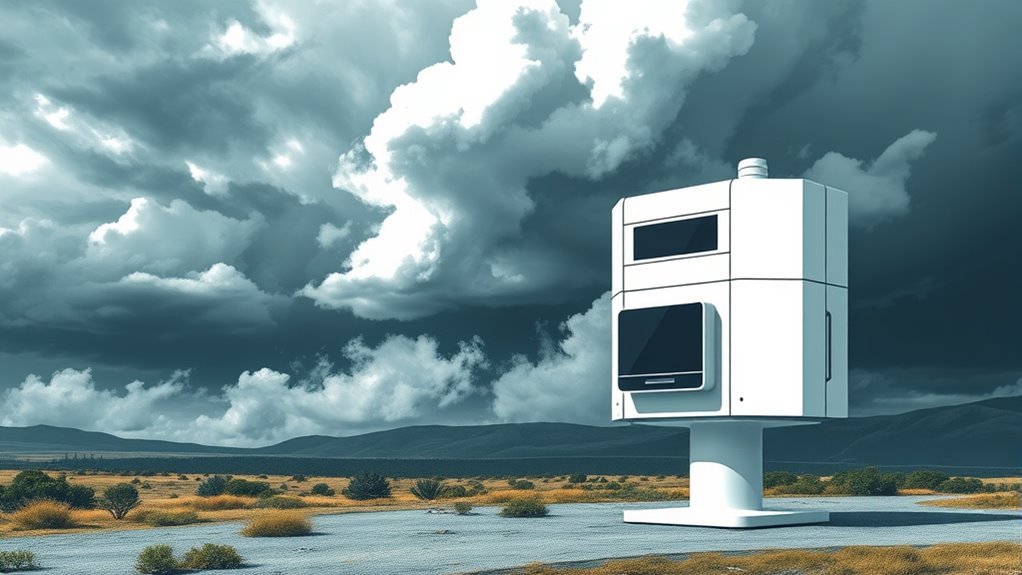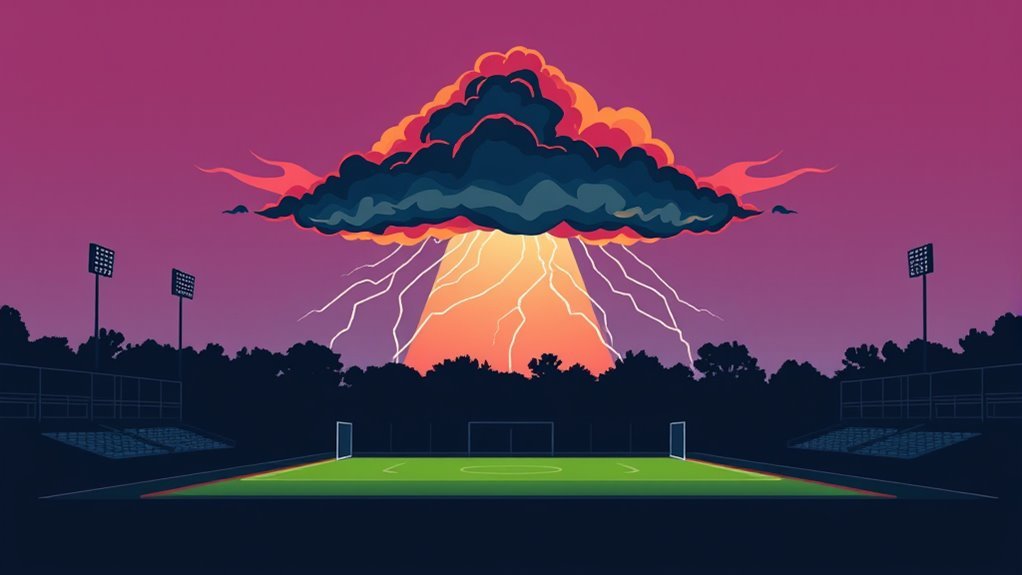Sudden squalls can severely disrupt outdoor events and sports due to their unpredictable nature. These intense windstorms bring heavy rain, hail, and strong winds, creating hazardous conditions for participants and spectators. Organizers must implement robust safety protocols and clear communication plans to manage potential disruptions. Real-time weather monitoring and quick response strategies are essential for ensuring safety. Understanding these dynamics is crucial for effective event planning and risk management in outdoor settings. More perspectives can be uncovered within the topic.
Main Points
- Sudden squalls can abruptly disrupt outdoor events, leading to potential cancellations or delays due to severe weather conditions.
- Heavy rain, hail, and strong winds from squalls pose safety risks to participants and spectators during outdoor sports.
- Event organizers must implement robust cancellation procedures and safety protocols to swiftly respond to sudden squalls.
- Real-time weather monitoring and effective communication plans are crucial for alerting attendees to changing weather conditions.
- Designation of safe shelter areas and clear evacuation plans enhances participant safety during unexpected squalls at events.
Understanding Sudden Squalls: What They Are and How They Form
Although often unexpected, sudden squalls are meteorological phenomena that can dramatically alter outdoor conditions. These brief but intense windstorms typically arise when warm, moist air rapidly ascends, leading to the formation of cumulus clouds.
As the air cools, it condenses into water droplets, creating storms that can produce heavy rain, hail, and strong winds. Sudden squalls usually occur when a cold front moves through an area, displacing warmer air and causing instability in the atmosphere.
Their unpredictable nature makes them particularly concerning for outdoor events and activities. While squalls can occur at any time of year, they are most common during changing seasons like spring and fall.
The formation and intensity of a squall depend on various factors, including temperature, humidity, and wind patterns. Understanding these elements is essential for anticipating sudden squalls and preparing for their potential impact on outdoor environments.
Impact of Squalls on Event Scheduling and Logistics

The unpredictability of sudden squalls necessitates robust event cancellation procedures to guarantee participant safety and logistical efficiency.
Organizers must implement safety protocols that can be activated swiftly in response to changing weather conditions.
Understanding these impacts is essential for reducing risks associated with outdoor events and sports.
Event Cancellation Procedures
Unpredictable weather events, such as sudden squalls, can considerably disrupt outdoor events and sports, necessitating well-defined cancellation procedures.
Organizers must have clear protocols in place to guarantee the safety of participants and spectators while minimizing logistical chaos.
Effective cancellation procedures typically include the following steps:
- Weather Monitoring: Regularly check forecasts and alerts from reliable sources.
- Communication Plan: Notify participants and attendees promptly through multiple channels, including social media and email.
- Decision Timeline: Establish a specific timeline for making cancellation decisions to avoid last-minute confusion.
- Refund Policies: Clearly outline refund or rescheduling options to manage participant expectations.
Safety Protocol Implementation
As event organizers manage the complexities of scheduling and logistics, the implementation of safety protocols becomes vital in the face of sudden squalls. These protocols often include real-time weather monitoring and communication strategies to guarantee participant safety.
Organizers must establish clear guidelines for evacuation procedures, site safety assessments, and emergency response teams. Additionally, contingency plans should be developed, allowing for swift adjustments to event timelines and locations.
Effective training for staff on these protocols is essential, making certain everyone understands their roles during adverse weather conditions. By prioritizing safety, organizers can minimize risks associated with squalls, maintaining a focus on the event's success while safeguarding all involved.
This proactive approach eventually improves the overall experience for participants and spectators.
Safety Precautions for Organizers and Participants
Organizers and participants must prioritize safety when planning outdoor events, especially in unpredictable weather conditions.
Implementing emergency weather protocols and effective communication strategies can considerably mitigate risks associated with sudden squalls.
Emergency Weather Protocols
While outdoor events and sports can offer exhilarating experiences, the possibility of sudden squalls necessitates thorough emergency weather protocols to guarantee the safety of both organizers and participants.
Implementing these protocols is vital for minimizing risks during unforeseen weather changes.
Key emergency weather protocols include:
- Monitoring Weather Conditions: Regularly check forecasts and weather alerts leading up to and during the event.
- Designating Safe Areas: Identify and communicate safe locations where participants can seek shelter quickly.
- Creating an Evacuation Plan: Develop a clear and efficient evacuation strategy to guide participants during emergencies.
- Training Staff and Volunteers: Ensure all personnel are trained in emergency response procedures, including first aid and communication protocols.
These measures can greatly improve safety and preparedness for outdoor events.
Participant Communication Strategies
Effective communication strategies are essential for ensuring that participants are informed and safe during outdoor events, especially when sudden weather changes occur.
Organizers must establish clear lines of communication, utilizing multiple channels such as mobile apps, text alerts, and public address systems to disseminate timely information.
Pre-event briefings should outline emergency protocols, ensuring all participants understand the appropriate actions to take when severe weather strikes.
Designated safety officers can be appointed to monitor conditions and relay updates.
Additionally, signage should be visible throughout the venue, providing essential information on weather alerts and safety procedures.
Case Studies: Notable Events Disrupted by Severe Weather

Severe weather has a history of abruptly interrupting outdoor events and sports, leaving organizers scrambling to modify plans. Remarkable incidents illustrate the impact of sudden squalls on these gatherings.
- 2015 U.S. Open: A fierce thunderstorm delayed matches, forcing players and spectators to seek shelter.
- 2004 Super Bowl: High winds and rain led to considerable transportation disruptions, impacting fan attendance and security protocols.
- 2016 Wimbledon: Unexpected rain caused extensive delays, resulting in a packed schedule and logistical challenges for organizers.
- 2020 Tokyo Olympics: Typhoon conditions forced changes to event schedules and safety measures, highlighting the need for flexibility.
These cases underscore the importance of contingency planning for outdoor events, as severe weather can drastically alter the experience for athletes and spectators alike.
The unpredictability of nature necessitates strategies to mitigate disruptions and guarantee safety.
Technology and Tools for Weather Monitoring

As outdoor events increasingly face the threat of sudden squalls, advancements in technology and tools for weather monitoring have become vital for organizers. Modern meteorological systems, such as Doppler radar and satellite imagery, provide real-time data on storm developments, allowing organizers to make informed decisions.
Additionally, mobile weather apps and specialized forecasting services offer localized updates, enhancing situational awareness.
Portable weather stations equipped with sensors for temperature, humidity, and wind speed are also gaining popularity. These instruments enable on-site monitoring, ensuring that event managers can respond promptly to changing conditions.
Moreover, social media platforms act as effective communication channels, allowing organizers to disseminate essential information quickly to attendees and staff.
Incorporating these technologies not only improves safety but also helps minimize disruptions, ensuring that outdoor events can proceed with the necessary precautions in place.
As a result, the integration of advanced weather monitoring tools has become a significant aspect of event planning.
Strategies for Quick Adaptation During Squalls
The increasing reliance on advanced weather monitoring tools has prompted event organizers to develop strategies for quick adjustment during sudden squalls.
These strategies aim to minimize disruptions and improve safety for participants and spectators alike.
Key tactics include:
- Pre-event Planning: Establishing weather contingency plans before events, which outline clear protocols for various weather scenarios.
- Real-Time Alerts: Utilizing mobile apps and text notifications to inform attendees of sudden weather changes and necessary actions.
- Shelter Designation: Identifying and marking safe areas for shelter, ensuring that all participants know where to go during a squall.
- Flexible Scheduling: Allowing for the possibility of rescheduling events or altering formats on short notice to accommodate changing weather conditions.
The Role of Communication in Managing Weather-Related Challenges
How can effective communication transform the management of weather-related challenges during outdoor events? Clear and timely communication is critical in ensuring the safety and well-being of participants and spectators.
Event organizers must establish robust communication channels to disseminate weather updates and safety instructions promptly. This involves using various platforms, such as social media, mobile apps, and public address systems, to reach diverse audiences swiftly.
In addition, pre-event briefings can prepare staff and volunteers to respond effectively to sudden weather changes. Training them in communication protocols improves their ability to relay information accurately, minimizing confusion during crises.
Engaging local meteorological services can further strengthen communication strategies, providing reliable forecasts and alerts.
Ultimately, effective communication not only aids in immediate response efforts but also nurtures trust among participants, ensuring a more coordinated and efficient approach to managing weather-related challenges.
Common Questions
How Do Squalls Differ From Thunderstorms?
Squalls are abrupt, intense wind shifts often accompanied by brief precipitation, while thunderstorms involve a combination of lightning, thunder, and heavy rain. Squalls typically last for a shorter duration than thunderstorms, showing distinct characteristics.
What Equipment Is Essential for Outdoor Event Organizers?
Essential equipment for outdoor event organizers includes tents for shelter, sound systems for announcements, first aid kits for emergencies, portable restrooms for convenience, and adequate lighting to guarantee safety and visibility during evening activities.
Can Squalls Occur in Any Season?
Squalls can indeed occur in any season. Their sudden nature is influenced by various atmospheric conditions, making them unpredictable. Consequently, individuals in affected areas must remain vigilant throughout the year to guarantee safety and preparedness.
How Can Spectators Stay Safe During a Sudden Squall?
Spectators can stay safe during a sudden squall by seeking shelter immediately, avoiding open areas and tall structures, and remaining informed through weather alerts. They should also stay calm and wait until conditions stabilize.
What Are the Signs Indicating an Approaching Squall?
Signs of an approaching squall include darkening skies, sudden temperature drops, increasing wind speeds, and changes in humidity. These indicators often precede heavy rain, lightning, and strong gusts, warning observers to take precautionary measures.

